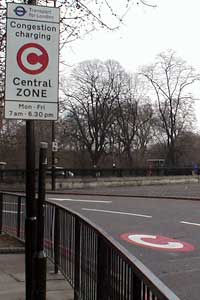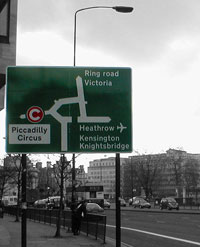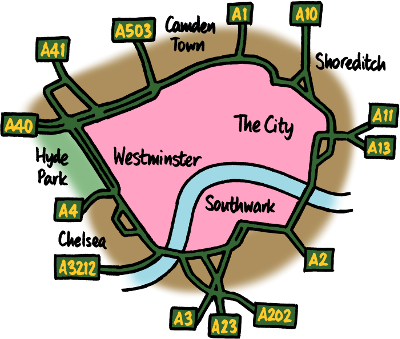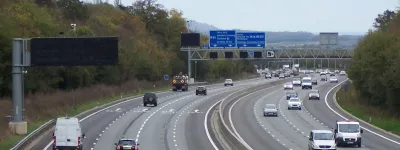If you're planning to drive in to Central London, it's not just the traffic you'll need to consider. There's also the Congestion Charge, a road toll applying across the City and West End to discourage journeys by road.
For many centuries, right through to the present day, London's traffic problems have been the stuff of legend. Cars, delivery vans and buses form a slow-moving swamp of vehicles down most of the main streets for most of the day, and have for decades. It's no surprise that, over the years, there have been all sorts of new and innovative proposals to clean up the mess.
Ken Livingstone, Mayor of London from 2000 to 2008, caused a political storm when he declared that he was going to charge motorists for something that has always been free to them — the roads. Introduced in 2003, modified in 2007, 2011 and 2017, the Congestion Charge Zone has remained controversial ever since.
This is not the official Congestion Charge website
For up-to-date information, and to make enquiries about the scheme, visit Transport for London.

What is the Congestion Charge?
The capital's traffic problems were not new when the motor car was invented. Even in the nineteenth century horse-drawn traffic choked its streets. There have been endless ideas and proposals to fix it ever since, but none have ever got very far or had much success. From the 1930s to the 1970s, proposals were made for new ring roads, dual carriageways, motorways, multi-level interchanges and tunnels to sort out the traffic, but they all faltered when faced with public opposition to the damage and destruction they would cause across the city.
With no way to build out of the problem, the traffic jams remained. A different kind of solution was proposed in the late 1990s by Ken Livingstone, a former leader of the Greater London Council in the 1980s who had been known for irritating the Conservative government with his socialist politics. He became known for pursuing policies that promote and subsidise public transport and sideline private traffic.
His solution to the traffic problem — which he was able to pursue after his election as an independent London Mayor in 2000 — was to impose a financial penalty on traffic in Central London, with the intention that it would be avoided by anyone not on truly essential business there, freeing up space for public transport and making the place more pleasant for pedestrians.

The Congestion Charge began operation on 17 February 2003 and was extended west to cover Kensington and Chelsea on 19 February 2007.
Ken Livingstone was succeeded as Mayor of London by Boris Johnson in 2008, who cancelled Livingstone's plans to link Congestion Charge pricing to vehicle emissions, and went on to scrap the western extension to the zone, returning it to its original boundaries, as shown above.
In 2017 the Congestion Charge was extended with an Emissions Surcharge (or "T-Charge") by Sadiq Khan, as the first stage of the introduction of emissions-based road user charges across London. Under this scheme, vehicles that do not meet certain emissions standards must pay almost twice the normal Congestion Charge.
In June 2020, as a condition of the Government's financial aid to Transport for London during the Coronavirus pandemic, the Congestion Charge cost was raised, the hours of operation were extended and the range of discounts and exceptions were altered.
Where and when does it operate?
The Congestion Charge zone covers Central London, including most parts of Westminster and the City of London. With certain exceptions, it encompasses the area within the Inner Ring Road, which forms its boundary and provides a way for through traffic to avoid it. The zone is marked by road signs and markings featuring a red disc containing a white "C". The roads forming the zone boundary are free to use.
From Monday 22 June 2020, the Congestion Charge operates Monday to Friday between 7am and 10pm, seven days a week. It is occasionally suspended in exceptional circumstances at the discretion of the Mayor, but does now apply on public holidays and in the period between Christmas Day and New Year's Day.
Vehicles entering the zone during the hours of operation are liable to pay a charge, and failure to pay the charge can result in steep fines or prosecution. The scheme applies to foreign-registered vehicles as well as British ones.
The Congestion Charge operates in addition to the Low Emission Zone and the ULEZ.
How does it work?

Direction signs
Travelling around London, every entrance to the Congestion Charge zone is marked unambiguously on direction signs on all surrounding roads. The red circular "C" symbol is used to indicate roads that lead into the zone.
A white version of the symbol is painted on the road in traffic lanes that lead to the Congestion Charge zone, and red-and-white symbols are painted across the road at entry points.
Signage for the Inner Ring Road was reinforced in 2003 and motorists wishing to avoid the charge should follow "Ring Road" wherever possible to stay outside the zone.

Caught on camera
Cameras are placed at every entrance and exit from the Congestion Charge zone. There is a black and white camera for each lane of traffic to capture registration plates, and a colour camera recording an overview of the whole road.
Vehicle registration plates are read automatically and processed at the control centre. The details are then checked against Transport for London's database. Images of exempt vehicles and those that have already paid the charge are discarded immediately. The rest are stored until a payment has been made.

Within the zone
Inside the Congestion Charge zone, there are occasional signs to remind motorists that they are subject to the charge, mainly to make it less likely that people will cross the zone boundary and then forget to pay.
There are also further cameras placed at strategic points throughout the zone to reduce the chances that vehicles will enter and go unnoticed. Mobile camera vans are also used at undisclosed locations.

Paying the charge
The Congestion Charge can be paid up to 90 days in advance or until midnight on the same day. Monthly and annual discounts are available for regular travellers.
The charge can be paid online, by phone, by text message, by post, or using TfL's "CC AutoPay" scheme. CC AutoPay users are entitled to a discount.
What do I pay?
The charge is dependent on the type of vehicle, the time it is paid and the method of payment.
Charges were correct at June 2020.
| Charge | Method of payment | Timescale |
|---|---|---|
| £15.00 | Phone, online or through the TfL "Pay to Drive" app | Paid in advance or paid before midnight on the day the charge is due. |
| £17.50 | Phone, online or through the TfL "Pay to Drive" app | Paid after the day the charge was due, but before midnight on the third day afterwards. For example, if the charge is due on a Friday, it must be paid by midnight the following Monday. |
The emissions surcharge or "T-Charge" no longer applies, and is replaced by the ULEZ.
What happens if I don't pay?
The charge can be paid at the normal rate until midnight on the day it was incurred. It can be paid until midnight on the third day afterwards at the increased cost of £17.50.
If the charge has not been paid after that time the registered keeper of the vehicle is sent a Penalty Charge Notice and is liable for a fine of up to £130. If the charge is then paid within 14 days it is discounted to £65.
In the event of non-payment, the black-and-white image of the car showing its registration number is stored for prosecution and possible court case, and the image from the colour camera is also stored to provide corroborative evidence (such as the colour and make of the car) to prove the vehicle was correctly identified.
It is thought that the cameras can be avoided if a vehicle changes lanes as it passes through one of the camera sites — confusing the system by not being in any particular lane at the point the cameras would register it — or by tailgating large vehicles in order to hide the registration plate. However, given the number of cameras in the system and the volumes of traffic at the time the charge is in operation, pulling off such a maneouvre reliably at every camera site would be almost impossible, and probably not worth the trouble for a £15 charge anyway.

Who is exempt?
Various exceptions and exemptions are permitted by Transport for London, which are detailed below (correct at November 2009).
| Charge | Types of vehicle | Action necessary |
|---|---|---|
| Free |
|
None |
| Free |
|
Register with TfL |
| Free |
|
Registration with TfL, incurring a £10 fee. In most cases this is renewable annually |
| Free |
|
Application to TfL for reimbursement |
The residents' discount for those living within the Congestion Charge zone, and the discount for motorists who had signed up to TfL's "auto-pay" system, were terminated on 22 June 2020. Transport for London described this change as temporary.

With thanks to Rob Fairhead for information on this page.

